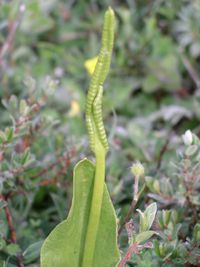- Ophioglossum
-
Ophioglossum 
Ophioglossum vulgatum Scientific classification Kingdom: Plantae Division: Pteridophyta Class: Psilotopsida Order: Ophioglossales Family: Ophioglossaceae Genus: Ophioglossum
L.Species Some 25-30, including:
Ophioglossum austroasiaticum
Ophioglossum azoricum
Ophioglossum californicum
Ophioglossum costatum
Ophioglossum crotalophoroides
Ophioglossum engelmannii
Ophioglossum lusitanicum
Ophioglossum nudicaule
Ophioglossum pedunculosum
Ophioglossum petiolatum
Ophioglossum polyphyllum
Ophioglossum pusillum
Ophioglossum pycnosticum
Ophioglossum reticulatum
Ophioglossum tenerum
Ophioglossum thermale
Ophioglossum vulgatumOphioglossum (adder's-tongue) is a genus of about 25-30 species of Ophioglossales in the family Ophioglossaceae, with a cosmopolitan but primarily tropical and subtropical distribution. The name Ophioglossum comes from the Greek, and means "snake-tongue".
Adders-tongues are so-called because the spore-bearing stalk is thought to resemble a snake's tongue. Each plant typically sends up a small, undivided leaf blade with netted venation, and the spore stalk forks from the leaf stalk, terminating in sporangia which are partially concealed within a structure with slitted sides. The plant grows from a central, budding, fleshy structure with fleshy, radiating roots. When the leaf blade is present, there is not always a spore stalk present, and the plants do not always send up a leaf, sometimes going for a year to a period of years living only under the soil, nourished by association with soil fungi.
Ophioglossum has the highest chromosome count of any known living organism, with 1,262 chromosomes. However, most species only have chromosomes in the 240-300+ range.
References
External links
Categories:
Wikimedia Foundation. 2010.
